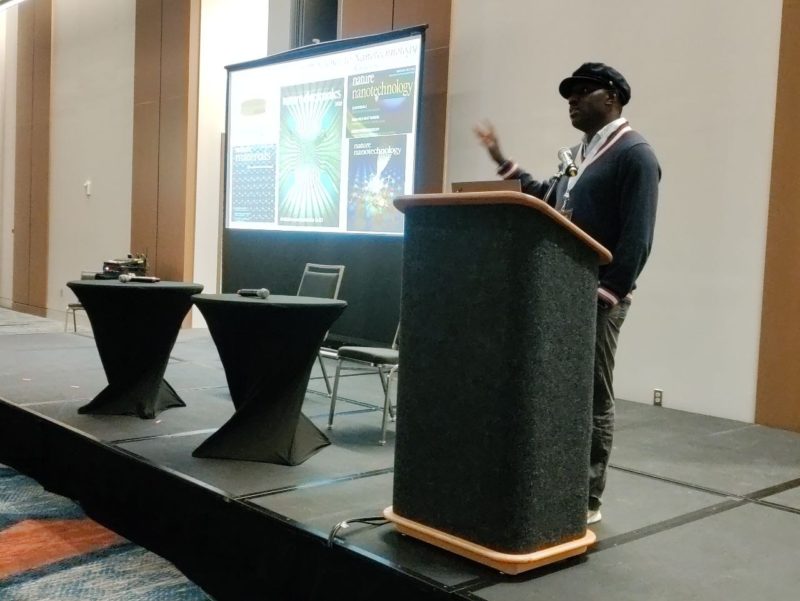
2-D materials usher in a renaissance of high-tech innovations
Deji Akinwande and colleagues at the University of Texas at Austin are developing a sensor that can test for COVID-19 and the flu simultaneously. (Photograph courtesy of the Cockrell School of Engineering, UT Austin.)
The future of medicine, computing, and energy optimization lies in two-dimensional materials, engineer Deji Akinwande told an audience of science writers gathered for a conference in Memphis, Tenn. on Oct. 22.
It’s been 12 years since Andre Geim and Konstantin Novoselov won the 2010 Nobel Prize in physics for the isolation of graphene, the thinnest and one of the strongest nanomaterials known in the universe. Since then, research on its applications has grown exponentially, explained Akinwande, a professor in the Department of Electrical and Computer Engineering at the University of Texas at Austin, during the Council for the Advancement of Science Writing’s New Horizons in Science briefings at the ScienceWriters2022 conference.

The applications of graphene and other two-dimensional materials like molybdenum disulfide and hexagonal boron nitride range from sensors to measure air quality, the presence of explosive and toxic gases and humidity levels, to high-tech cameras with enhanced night vision and biosensors that could increase the precision, speed, and accuracy of viral testing.
At the beginning of the COVID pandemic, Akinwande joined forces with the San Diego-based biotechnology company Cardea Bio to develop multi-diagnostic testing devices. Their idea is to attach linker molecules to a sensor to connect it with antibodies or other chemical substances that will react to a sample and identify viruses. Because the technology is electronic, made of tiny transistors that respond to changes in a molecule’s electrical charge, results appear very quickly.
Graphene biosensors can simultaneously test for influenza, SARS-CoV2 and other viruses and their variants to determine the cause of a patient’s symptoms more accurately. “There’s a concern that many viruses may have similar symptoms,” said Akinwande.
Wearable sensors for diagnosis, prediction, and prevention
The platform is so versatile and sensitive that it could lead to the development of testing devices that sample breath to diagnose COVID-19 and other diseases. “You can achieve the results in 10 seconds. Not just for COVID but for other emerging threats,” Akinwande said. The benefits also extend to telemedicine diagnosis. There are more and more wearable devices that measure people’s vital signs and send them to the doctor’s office electronically.
Akinwande likes to think of the human body as an electrical machine. The heart’s electrical signals, for example, provide information about the health and well-being of the person. This branch of medicine, called electrophysiology, has long relied on invasive and sometimes painful procedures, such as inserting wires and electrodes through catheters to measure electrical activity through the blood vessels that enter the heart.
Not any more. “In my lab, we use electronic tattoos instead of [the] big cables that you may experience in the hospital,” Akinwande said.
Akinwande and his colleagues place the tattoos on different parts of the body and measure the signals sent to a computer. Using machine-learning techniques to interpret the signals in context, they can differentiate between an event such as a workout session, where elevated blood pressure is normal, and one that needs immediate attention, such as a blood-pressure spike in the middle of the night.
Gathering enough data about a person could lead to predictive and preventive medicine. It can also help doctors sense the vital signs of a patient even when they’re not in the same place. Yet gathering more data requires higher energy consumption.
Experimental data from the Semiconductor Industry Association showed that in less than 20 years, the energy consumption generated by information and communication technologies will exceed the available energy produced in the world. “This is an energy catastrophe,” Akinwande said. That’s why there are great efforts to make electronic systems more energy-efficient.
One of these efforts is neuromorphic computing, which takes inspiration from how the human brain processes great quantities of data with low energy consumption. Building computers that mimic the brain in this way, Akinwande said, will depend on the development of 2D materials. The physical properties of these materials can easily be modulated by various stimuli, enabling them to serve as the synapses in a future neuromorphic computer.
Research into the uses of these materials is just beginning. There are many policy dilemmas, starting with how a patient’s personal data is protected when all our vital signs end up in a networked cloud of computers. Science also needs to solve some conundrums, such as how to achieve energy efficiency while increasing the amount of data we process, something Akinwande called the catch-22 of the field.
Still, Akinwande told the science writers, this is a very exciting time to do this research.